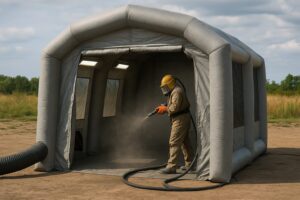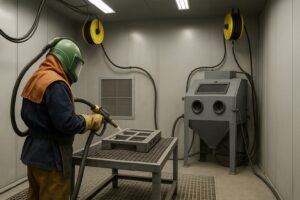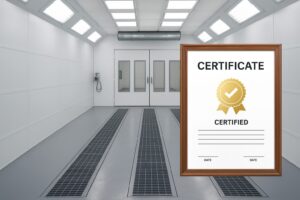A well-designed sandblasting booth does more than just contain grit and dust; it streamlines the entire surface-preparation process, reduces operator fatigue, and maximizes throughput. Whether you’re refurbishing automotive parts, prepping metal for painting, or tackling industrial equipment, thoughtful booth layout can shave hours off your day and significantly cut material waste. Below, we explore key strategies for optimizing your sandblasting workflow, from the moment a part enters the booth to the instant it rolls out, ready for the next stage.
Understanding Your Workflow Needs
Before rearranging equipment or shifting walls, start with a clear picture of how work actually flows today. Map out every step: loading parts, blasting, dust extraction, inspection, and unloading. Talk with operators to learn where bottlenecks occur:
- Waiting for access: Are operators queuing up outside the booth because the table is occupied?
- Material handling delays: Does simple movement, lifting heavy parts in and ou,t weaken productivity?
- Downtime for maintenance: How often do you pause blasting to replace filters or clean the booth?
By pinpointing friction points, you’ll know whether to tackle throughput, ergonomics, or maintenance first. This targeted approach prevents wasted efforts and ensures layout changes solve real problems.
Designing for Smooth Material Flow
The “golden path” through your booth should be as straight and obstacle-free as possible. Imagine the journey of each workpiece:
- Entry Zone: A staging area just outside the booth keeps incoming parts organized and off the floor.
- Blasting Chamber: Center your blasting table or hang fixture so operators can reach all sides comfortably.
- Exit Zone: On the far side, a place to roll out finished pieces without backtracking through the spray pattern.
When these zones align in sequence, you eliminate loops or cross-traffic where dust and grit linger on operator boots and spread throughout your facility. Use visual floor markings bright tape or painted lines to reinforce the intended path.
Strategic Equipment Placement
Hang hoses from overhead retractors to keep them off the floor and reduce strain on the operator. Overhead trolleys allow the gun to follow the operator’s movement fluidly, preventing kinks that can disrupt abrasive flow. Aim for:
- Minimal bends: Every elbow in a hose adds pressure drop, making blasting less consistent.
- Sufficient length: Hoses should reach the furthest edges of big parts without tension.
Dust Collector Proximity
Your dust-collection unit should sit as close to the booth as practical, with ductwork running straight into the collector. Sharp turns and long runs not only increase installation cost but also reduce airflow, letting dust linger and eventually settle back into the blasting area. A well-sized hood just inside the booth door accelerates the removal of airborne grit.
Lighting and Visibility
Bright, evenly distributed LED lighting minimizes shadows and glare so operators can see subtle surface defects. Mount fixtures outside the spray zone behind protective glass. When operators see exactly what they’re blasting, they avoid over- or under-processing areas, saving time on touch-ups.
Ergonomics and Operator Comfort
Sandblasting is physically demanding, so a layout that reduces bending, reaching, and awkward postures pays dividends in productivity and morale.
- Adjustable work surfaces: Tables or turntables that raise and lower accommodate operators of different heights and large vs. small parts.
- Foot space: Keep the area under the table clear of hoses or brackets so operators can shift their stance.
- Anti-fatigue mats: Durable rubber mats reduce strain on legs and lower back during long blasting sessions.
Encourage regular breaks and job rotation, perhaps alternate blasting shifts with inspection or media-recovery duties, to stave off fatigue and keep everyone sharp.
Safety First, Efficiency Follows
Optimizing workflow shouldn’t compromise safety. In fact, clear safety protocols and well-organized personal protective equipment (PPE) stations often speed up operations:
- PPE station near entry: Respirators, gloves, and ear protection should live just outside the booth so operators can suit up without hunting for gear.
- Emergency exits and fire suppression: Clearly mark pathways and keep extinguishers within easy reach. When everyone knows exactly where to go in an emergency, drills happen faster and with less confusion.
- Spill containment: Position reusable abrasive-collection bins under the table to catch used media. Clean-up then becomes a quick swap of containers rather than sweeping grit across the floor.
A culture of safety reaffirmed by visible, well-maintained equipment goes hand in hand with smooth, uninterrupted production.
Media Recovery and Recycling
A booth that integrates media recovery transforms waste into savings. Under-table conveyors, vibratory sifters, and magnetic separators all help reclaim reusable grit:
- Underbelly conveyors feed spent media to a collection bin.
- Sifters remove fine dust and broken grit, preserving only sharp, effective particles.
- Magnetic separators pull out steel shot or particles from mixed media runs.
Locate recovery machinery adjacent to the booth’s exit zone so operators can simply wheel out full bins and wheel in empties without retracing work steps.
Continuous Improvement Through Data
Lastly, bake in ways to monitor and tweak performance. Simple counters and logs can reveal trends:
- Blasting hours per shift: If throughput drops at certain times, investigate whether filter changes, maintenance, or staffing levels are to blame.
- Media consumption rates: Unexpectedly high usage may signal worn-out media, incorrect nozzle size, or poor abrasive quality.
- Downtime records: Track how often and why the booth stops—planned maintenance, unexpected breakdowns, or operator delays.
Regular review meetings, perhaps weekly stand-ups in front of a whiteboard, keep everyone accountable. When data drives decisions, layout tweaks are tested and validated rather than guessed.
Bringing It All Together
Optimizing a sandblasting booth layout is a bit like tuning a high-performance engine: small refinements multiply into big gains. By organizing entry and exit zones, placing equipment for smooth movements, prioritizing ergonomic comfort, and integrating media recovery, you transform a dusty workshop corner into a highly efficient production cell. Regularly reviewing performance metrics ensures that layout changes pay off and spur fresh ideas for further refinements.
Remember, the best layout respects the people who use it. Involve operators in every step from mapping workflows to evaluating new hose retractors and you’ll not only boost throughput but also foster pride and ownership in a safer, more productive workspace. With streamlined workflows and continuous improvement, your sandblasting operation will be ready to tackle any surface-preparation challenge that comes its way.
Specialized Sandblasting Booth Services
We specialize in providing top-quality sandblasting booths and custom finishing solutions tailored to meet the unique needs of various industries. Our expert team designs and manufactures state-of-the-art sandblasting booths that ensure safety, efficiency, and superior performance. From automotive and aerospace to marine and industrial applications, our booths are engineered to handle even the most demanding surface preparation tasks. We offer comprehensive services, including booth installation, maintenance.




